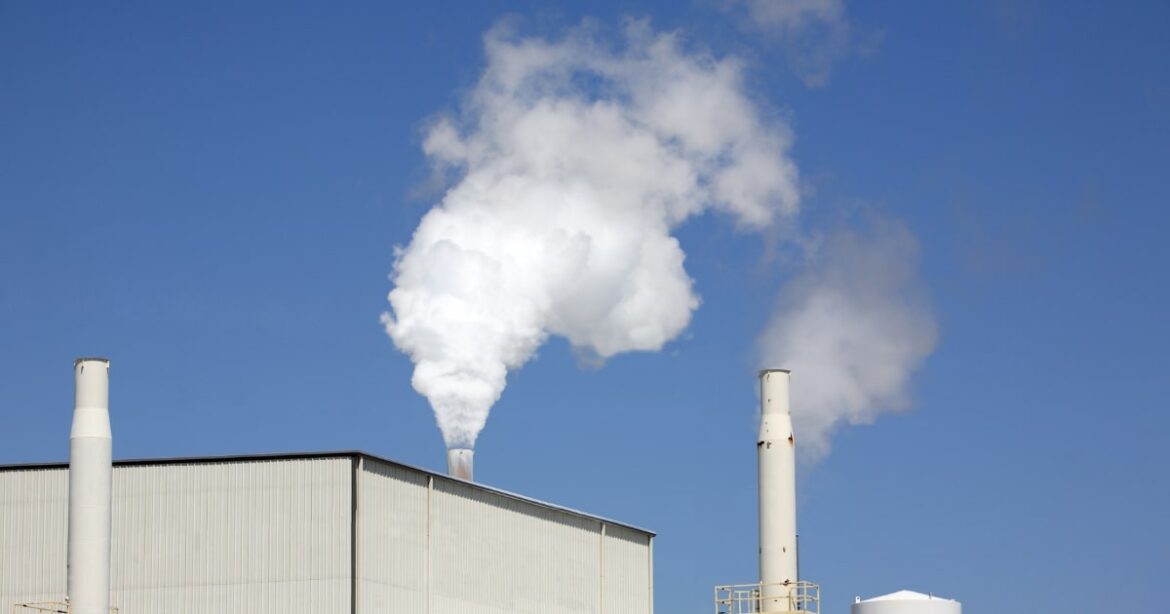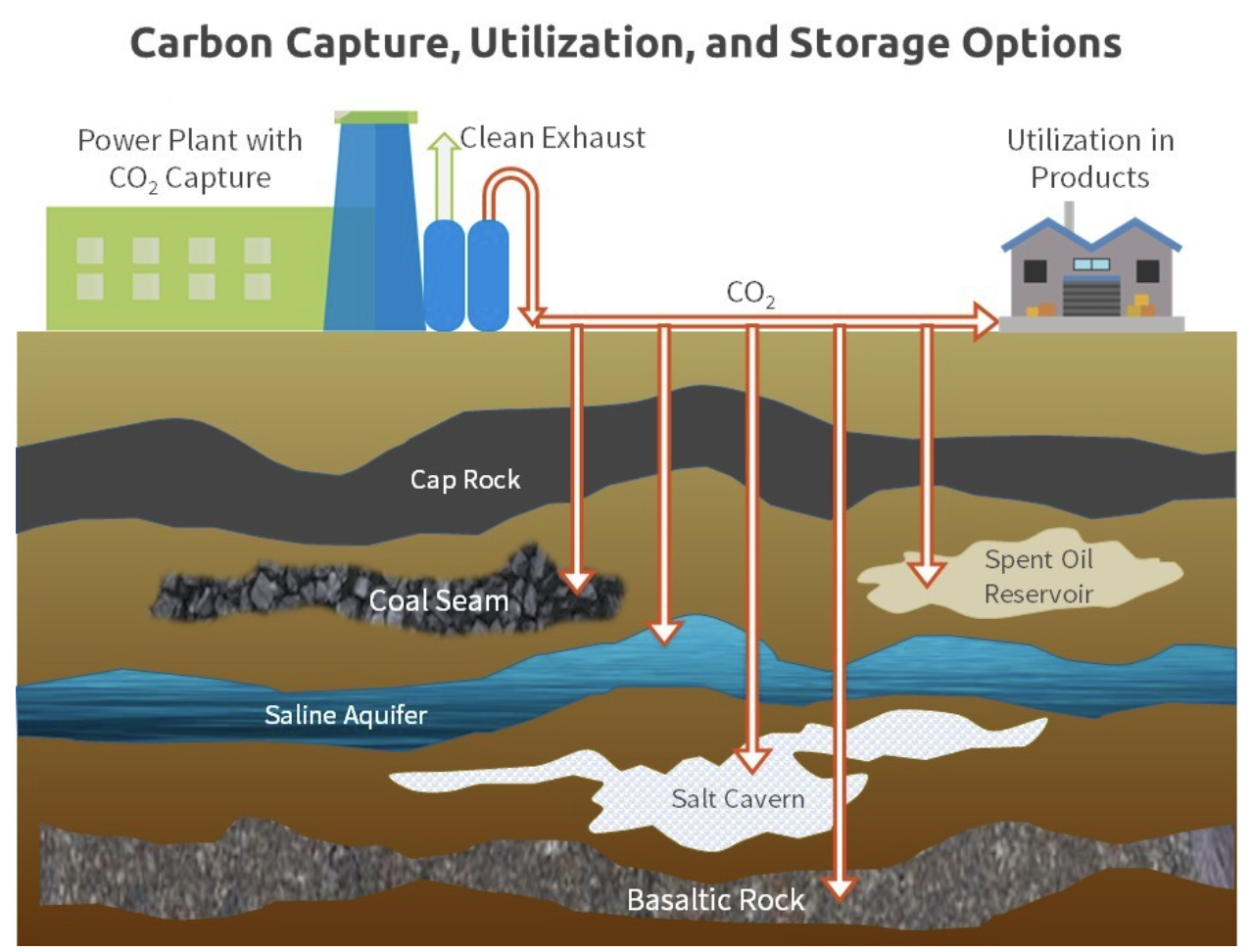
By Rick Knight
What is carbon capture, utilization, and storage?
Carbon capture is a way to remove carbon dioxide (CO2) from some mixture of gases. If CO2 is removed from an emissions source, such as the exhaust gas from a power plant, and then sequestered out of the atmosphere, it doesn’t contribute to global warming or ocean acidification. Utilization means converting the CO2 into some long-lived product, while storage just means putting it away somewhere safe and permanent.
How does carbon capture and storage work?
The core technology here is carbon capture, even though it’s technically carbon dioxide, not carbon, that’s captured. The source of the CO2 could be a power plant, a refinery, a chemical plant, or any facility where CO2 would otherwise be allowed to escape. Scrubbing CO2 out of industrial gases with certain types of solvents is widely used for processes where it is an unwanted contaminant, such as in natural gas. In some cases the captured CO2 has been sold to oil drillers to push more oil out of old wells – a kind of utilization called enhanced oil recovery (EOR). Other, more environmentally friendly routes for utilization of captured CO2 include cement, polymers, carbon fibers, animal feed, or even alternative fuels that would be considered carbon-neutral. But utilization pathways are limited in size. To store the vast amounts of CO2 that are emitted today, geological sequestration is needed. Potential destinations for storing large amounts of CO2 are in depleted oil and gas reservoirs, deep underground formations capped off with impermeable rock, or even underground deposits where it gradually combines with existing minerals. Recent testing has confirmed that a common type of rock called basalt can react with CO2 more quickly than previously expected.
Why isn’t CCUS already being done at commercial scale?
Until a new tax credit called the 45Q credit was introduced in recent years, there was no financial incentive for power plants or most manufacturers to capture CO2 solely to keep it out of the atmosphere. But now that there is such an incentive, a lot of projects are moving forward around the world. In the US, the 45Q policy will pay $60 per ton of CO2 if it’s used for EOR, and $85 per ton if it’s converted into products or sent to geological sequestration.
How can CCUS help fight climate change?
Carbon capture, utilization, and storage (CCUS) will almost certainly have to play a vital role in climate policy, because winding down fossil energy will take time. That’s why carbon tax proposals in previous Congresses provided carbon fee refunds or credits for fossil CO2 that is captured and sequestered. Many studies of potential routes to cutting greenhouse gas pollution, including ones from Columbia University, the Deep Decarbonization Pathways Project, and the World Bank, consider CCUS as one of the technology options likely to be necessary. If done safely and permanently, CCUS can help cut emissions while facilitating an orderly transition away from fossil energy.
In a Nutshell: Carbon Capture, Utilization, and Storage (CCUS), if done properly, will need to be an essential piece of the climate puzzle. The electrical grid and distribution networks for oil and gas are complex and intimately tied to our economy, so it will take time to reinvent those networks – time we simply don’t have – with minimal disruption. CCUS can help maintain stability in our energy systems while maximizing the rate of decarbonization through an orderly transition.
Deeper dive: Carbon capture is controversial, with some calling it a false solution that will prolong our dependence on fossil fuels, and others claiming that we can’t achieve our climate goals without it. It’s imperative that we base our position on a clear understanding of the facts.
Carbon capture – the “CC” in “CCUS”: Any time a carbon-containing substance is burned, it produces carbon dioxide (CO2), the principal greenhouse gas driving climate change. Finding ways to separate out that CO2 before it exhausts into the atmosphere and then immobilize it in some way would help slow down global warming.
Methods to capture CO2 in various solvents have been around for more than 100 years, so applying those methods to remove CO2 from the exhaust of various kinds of plants is a relatively straightforward engineering task, depending on how concentrated the CO2 is, how much gas cleanup is required, and how to cover the extra cost. The climate impact of CCUS is also different for fossil fuels than for bio-derived fuels.

Applying carbon capture to coal plants requires it to be preceded by removal of nitrogen oxides (NOx), particulate solids, and sulfur gases. Natural gas combustion produces less NOx and near-zero particulates and sulfur, so CCUS is less costly to apply. Biomass offers the possibility of carbon-negative energy or products – an approach known as bioenergy with carbon capture and storage (BECCS).
The next step after capture is to compress the CO2 and put it someplace where it won’t add to planetary warming or ocean acidity. The diagram below shows some of the pathways available to sequester CO2.

Utilization – the “U” in “CCUS”: Although CO2 capture has been used on natural gas since the 1920s in order to meet pipeline gas specifications, there was only one way to recover the cost: by selling the CO2 to oil producers for enhanced oil recovery (EOR), where the CO2 is injected into depleted oil wells to force out more oil. But when the goal is fighting climate change, that doesn’t sound like such a great idea. More climate-friendly utilization options include sequestering it chemically in cement or concrete, incorporating it into polymers, converting it into carbon fibers, or using it to synthesize carbon-neutral fuels (electrofuels). However, it must be pointed out that the total potential for CO2 utilization is only a few percent of what is possible if the gas is sent to geological sequestration, where it is pumped deep underground into formations where it stays put or even becomes “mineralized,” which means chemically bonded to the earth.
Storage – the “S” in CCUS: The potential worldwide geological storage capacity is huge! The International Energy Agency estimates that salt caverns, saline aquifers, depleted oil and gas wells, and abandoned mines could store enough CO2 to account for 215 to 1490 years of today’s emissions, and if storage in basalt formations, where recent testing has shown that CO2 could be mineralized in just a few years, proves to be feasible at large scale, that storage potential could grow a thousandfold.
The economics: As mentioned earlier, the natural gas industry has long captured and sold CO2 for EOR, but capturing it from other industrial plants or electric utilities is more costly. In the absence of greenhouse gas regulations – or a carbon fee –carbon capture has not taken hold except in a few demonstration plants. That changed with the 45Q tax credit, introduced in 2008 and then enhanced in 2022 via the Inflation Reduction Act. That policy will pay a facility that captures at least 75% of their CO2 $85 per ton – $60 per ton if used for EOR – and has prompted many industries to jump on the bandwagon. The added cost of CCUS, including transport and storage, ranges widely, from $60 to $330 per ton in power generation and from nearly $0 to $300 per ton in other industries.
Do we really need it? Power plants and industrial facilities are responsible for half of our nation’s CO2 emissions, and most of it pours out of smokestacks. Even in the face of climate urgency, many of those plants will still need to keep operating for some time to ensure grid stability and continue supplying essential products. As the contribution of variable renewables to our power grid grows, dispatchable generators are needed to back them up. Other industries can eventually transition to clean energy, but even under the most optimistic scenarios for renewable deployment, this will take decades. The IPCC has also forecast that carbon-negative technologies like BECCS will be needed in order to achieve net-zero conditions by mid-century.
The Princeton Net-Zero Report describes five distinct net-zero pathways that would depend on a combination of political and market decisions. All of the scenarios assume that 0.7 to 1.8 billion metric tons of CO2 are captured, mainly from natural gas and/or biomass. Four of the five presume >82% of it would end up underground. The large range of CCUS forecasts depends on a variety of factors, such as the amount of electrification, regulations and policy, and growth of other technologies.
Issues with CCUS: As with any technological change, there are concerns. Among those is the fear that actively supporting CCUS will divert resources away from other clean energy options and lead to technology “lock-in” as new natural gas plants are built and commissioned. A related concern is the need to expand the existing network of CO2 pipelines, which has stirred up local opposition in the wake of a 2020 CO2 pipeline rupture in Mississippi that was poorly handled. Widespread adoption of BECCS could create conflict over land use and siting. All of these concerns can be addressed, but it will take diligent and consistent regulatory oversight and monitoring.
Bottom line: CCUS is almost certainly going to be needed to help navigate an orderly decarbonization of our economy, but the extent is yet to be determined. The vast majority of captured CO2 will need to go deep underground. There will be bumps in the road, and it will be costly, like everything else we need to do. CCL can play an essential role as a reliable source of information for lawmakers, advocacy groups, and the public alike.
Make an impact today



